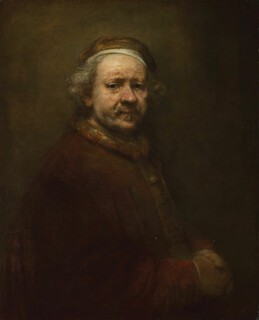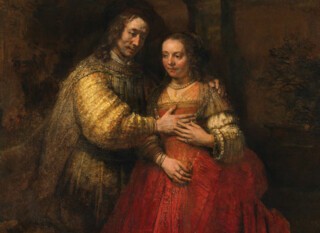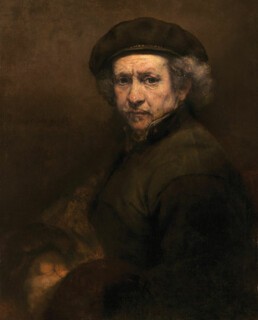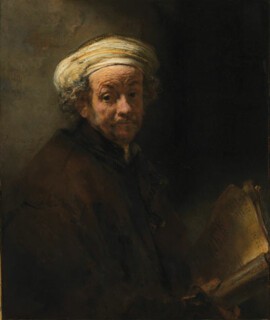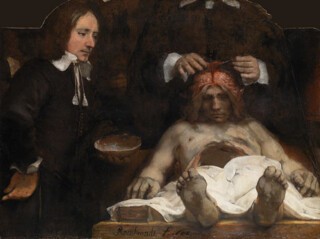They say that when Jean Genet made occasional visits to London after the war his first stop was always the Rembrandt room in the National Gallery, to see Self-Portrait at the Age of 63. The portrait is dated 1669: Genet believed it was the last Rembrandt painted. (Not true, apparently.) He wrote a short essay called ‘Rembrandt’s Secret’ for L’Express in 1958, and in his unfailingly Manichaean way he wanted to convince his readers of Rembrandt’s goodness. This is what the picture made manifest, he felt. Goodness as a quality of character, primarily, looking evil in the face; but that aspect or dimension of the human brought into being by the act of painting. Fleshed out, so to speak. ‘I use the word bonté as shorthand,’ he wrote. ‘Rembrandt’s last self-portrait seems rather to be saying this: “I shall be so intelligent that even the wild animals will recognise my goodness.” The morality that guides the artist, then, is not the vain quest for a proper apparel for the soul [une parure de l’âme], it is the métier itself, insisting on goodness, or rather, bringing goodness in its wake.’
These are difficult sentences, and my translation works hard (too hard) to make them easier, but their terms came back to me immediately the other day as I rounded the corner and stood in Room One of Rembrandt: The Late Works. Out of the darkness came four self-portraits – the National Gallery’s, and paintings from Washington, the Mauritshuis, the Rijksmuseum – plus a strange, half-effaced, tender, despairing little print of the artist at work on an etching. The faces leaped towards me. Who they were and what they were thinking seemed secondary to the sheer outwardness of their attention: the wide-eyed, calm focus, which on one level might simply be that of a painter intent on getting the shine on a nose imprinted in his nervous system. Of course I knew that what the faces were attending to was ‘themselves’, but whether that idea was singular or plural to them, or whether they thought of it at all in terms of ‘outsides’ and ‘insides’ – as a matter capable of being looked at empirically – seemed questions that the paintings raised one moment, and consigned to outer darkness the next. The darkness in Rembrandt (which has always perturbed those confronting him, whether they have chosen to valorise it or not) did have the look, in this world of raised eyebrows and faint smiles about puffy lips, of ‘doubt about the self and its motives’ – the realm of the Protestant conscience, the world Erich Auerbach taught us to recognise as always ‘fraught with background’ – but out of this background, all the brighter for emerging from the murk, seemed to come a final decisive exteriority to the soul, a materiality, a workmanship. I think the intertwining of these three notions is what Genet’s words ‘goodness’ and ‘intelligence’ were meant to suggest.
Twenty years ago when I wrote an essay on self-portraiture, it was the question of outside and inside that seemed to me key to the mystery. I thought the character of Rembrandt’s ‘look’ in the National Gallery canvas derived from its being locked into – maybe trapped inside – a series of spatial and spiritual boxes. (The Rembrandt imagined in Self-Portrait as Apostle Paul, next door to the National Gallery picture in the present exhibition, is specifically put in prison: restorers tell us there are bars on a window just visible in the gloom.) Let us assume – this was my previous starting point – that what we are looking at in a self-portrait is the image a painter saw in a mirror. It seems to follow that the kind of attention we are shown is special, not to say exotic: the look of someone looking at himself looking. The trouble is that we can only decide where to put an end to that final phrase by pure fiat. It seems designed to go on for ever:
The look of someone looking at himself looking at the look he has when it is a matter of looking not just at anything, at something else, but back to the place from which one is looking … Would that do better? Is that what self-portraiture is about? Simple questions in this area seem to open onto infinite dialectical regress. And isn’t one of the things we admire in the best of the genre precisely the effort to represent this dialectical vertigo? Isn’t that what Rembrandt is doing?
Maybe. There are moments in Room One when questions of this kind do crop up. Dialectical intricacy is part of the game. Maybe the shadowy page of scripture in Self-Portrait as Apostle Paul is meant as a metaphor for the interiority – the space of hidden meanings – that the look in the mirror can never quite reach. Light hits the apostle’s face, exposing its ruined façade; what is ‘inside’ it – what it is thinking and fearing – will always remain a kind of writing in the dark.
Nonetheless, I did not find in the show that being caught in the crossfire of Rembrandt’s four gazes provoked new feats of dialectic. It mainly cancelled the old ones. I did not think that my previous scepticism about inside and outside in the model of mind quite captured what was happening as I turned from one picture to another. Somewhere in the back of my consciousness I clung to the idea that self and other, exterior and interior, immediacy and reflection were distinctions that shaped the look I was trying to come to terms with. I wanted to resist the distinctions, or at least question them, but I knew that the look short-circuited my intellectual defences. It addressed me directly. It put me in the place of self. Rembrandt and I – the look was our term of agreement – were face to face.
Let us call this the Rembrandt effect. It is an immensely powerful one, whose mechanics remain largely a mystery. It proved inimitable; or rather, the imitations seemed often to get the mechanics right, but mostly failed to deliver the effect. People in the 17th century appear to have wanted the effect and been willing to pay for it. Their dismal handbooks of art theory (and even more dreadful guides to the progress of the soul) had nothing germane to tell them about the picture of self on offer from the disreputable showman, with his ‘whore’ of a wife and his sordid bankruptcy, but there was apparently a thriving market for the kind of face-to-faceness he specialised in. A market for the unspeakable, we might say. Whether or not Rembrandt was bankrupt, his prices remained high. Italian noblemen and international bankers beat a way to his door – a German called Everhard Jabach, art dealer-cum-financier in Paris, seems to have been the first owner of Self-Portrait as Apostle Paul. Shades of the prison house clearly appealed.
What I now think was wrong in my previous approach to Rembrandt was my choice of terms. My essay assumed that the ‘look’ of self-portraiture was paramount, and extracted the look from the ‘face’. Rembrandt did not. His pictures – not just his self-portraits, but the whole world he shows us, predicated as it is on faces – have to do centrally with the belonging of eyes and eyesight to the unlikely cluster of ‘features’ that cling to the lower front half of the skull, exposing the brain to the world. Exposure of this kind has dangers. It is entirely horrible when, in The Anatomy Lesson of Dr Deyman, Joris Fonteijn’s brain is literally laid bare. But the proximity of The Anatomy Lesson to the self-portraits in the show – one among many unnerving conjunctions – only serves to alert us to the strangeness of the brain’s everyday, non-horrible externalisation. (What word will do here? ‘Appearance’ is weak, ‘apparatus’ too Cartesian, ‘outlook’ too clever. The cant word ‘interface’ might serve.)
Rembrandt paints faces. When he finds himself in a world where appropriate facial expressions do not come to mind he is in trouble. The Conspiracy of the Batavians, battered a bit cruelly by the lights in Room Two, shows him hitting an imaginative brick wall. In his few and uncanny landscape paintings (none of them from his last years) he seems to make a virtue of being out of his depth: no other depictions of the countryside, not even Cézanne at his most stony, seem so intent on showing nature as a territory human beings have strayed into essentially by mistake. But the world of faces is rightly his, and ours in turn: we inhabit it as we would a hall of mirrors. Rembrandt struts about the darkened room, owner and impresario, and what he intends to show us above all is our powerlessness in the ‘face’ of physiognomies. A face, he will demonstrate, is a machine for exteriorising – exchanging, universalising – subjectivity. (Rather in the way Le Corbusier thought a house was a machine for living in.) This is what the arrangement of nose, ears, eyes, cheeks, mouth and chin, plus muscles to give them special mobility, was evolved to do: to make the sensory apparatus of each individual respond to the apparatus of others; to make the ‘features’ into signs; to have eye and mind focus only on those vectors of another’s facial appearance that matter semantically. The face is the form of the brain in the world. This peculiar array of receptors, so close to the grey matter pulling their strings (too close for comfort, Dr Deyman reminds us); all these weird openings and protuberances, set out in a symmetry that only just naturalises the bizarrerie – what are they but organs essentially avid for response, reciprocation, acknowledgment, mutuality? And ferocious if response doesn’t follow. A face is a machine for universalising the ‘I’. The ‘I’ can draw back from the process and interest itself in the machinery, recording evidence of wear and tear. Obviously Rembrandt did. But even in such moments of half-disengagement – here is what the late self-portraits show – the universal is triumphant. A face that encounters itself as an object, be it exhausted or immaculate, is always an ego luxuriating – fully and wonderfully entrenched – in its being-in-the-world.
My eye swerves left from Apostle Paul to the self-portrait from Washington next to it, done two years earlier. The pose is reversed. The realm of the Word has been left behind. Blurred hands grip one another: the fingers of the hand furthest away are like tongues of slow-moving lava. They invite us to touch – to fill out their approximation. ‘Placeholders’ would be a word for them. Rembrandt’s gaze, by contrast, is all insistence, assessment, sight screwed to the sticking point, materialisation. The force of such outwardness leaves affect in doubt (heaven knows what Rembrandt is feeling), but this too we experience as an aspect of character, the pressure of an ego against us. The gaze here could perhaps be understood as directed to a picture rather than an image in a mirror. It is practical: severe in judgment, but admiring of its handiwork. So intelligent that the animals bow down. Such is the self.
I found it hard to escape from Room One in the exhibition, you will gather, and I gravitated back to it constantly from the intensities that followed. It was as if I needed the shelter of the self-portraits (and there is a further one in Room Two: the famous enigma from Kenwood) in order to get the measure of Rembrandt’s feeling for the world at large. The feeling is relentless. One turns away from the blood streaking Lucretia’s shift in Room Two – the second version of the subject, done in 1666 – only to find oneself sucked into Joris Fonteijn’s abdominal cavity. The Syndics, a few yards further on, devour the space of their room. Through the door The Jewish Bride smoulders on a far wall, across from Titus at His Desk and Woman Bathing in a Stream. The great portraits of the Dutch one per cent (whom the writers of wall labels reassure us are ‘ordinary people’) keep on coming. Bathsheba and Simeon with the Christ Child and Jacob Blessing the Sons of Joseph make up the rear. (I have not even mentioned etchings and drawings – an incomparable selection.) Cumulatively, it brought on the feeling I’ve always had as the last chorale of the St Matthew Passion starts up. I find myself wondering if human beings are properly equipped to deal with intensities of this kind. But it’s worth the risk.
Just because the display of Rembrandt’s vision here is so comprehensive, the show is likely to jolt the viewer into thinking about what the vision consists of, and how it can go on being administered in such strength. It must depend on exclusions. The darkness is our guide here: in order for a part of the world to be fixed on repeatedly, and be offered as sufficient and transfixing, an enormous surrounding – say, the world as plotted by Koninck and Vermeer – has to be left in shadow. That raises the question of Rembrandt’s colour. Of course one accepts, completely and without thinking, the blaze of red, gold, off-white and endlessly modulated flesh pinks and yellows that is the key (a further key) to the Rembrandt effect. To say that Rembrandt is a supreme colourist is to state the obvious. Only look at the way the white linen of Woman Bathing in a Stream gathers touches of yellow from the dress discarded on the bank. Or the awful triumph of Lucretia’s green undergarment. Or the coal-fire red in The Jewish Bride, and the softness of whites and golds, like dirty snow, in Simeon with the Christ Child. Nonetheless, it came on me as I went from room to room what a very strange ‘supreme colourist’ I was looking at. What other colourist worth the name is so little interested in the spectrum beyond yellow? Why does it seem that blue and green – Giotto blue, Bellini blue, the blue of Vermeer and Van der Weyden – hardly existed for Rembrandt? Blue, as far as I can see, is truly absent from his world. Green appears very occasionally, but always as a sign of pallor and putrefaction more than photosynthesis. The green in Lucretia is death incarnate. The pot plant in The Jewish Bride is a ghost.
It may be that partly this has to do with practicalities, material events – fading and darkening of colours, the price of pigments and so on. But this cannot be decisive. We are dealing so clearly with an aesthetic choice, which is in turn an ethical and hermeneutic one. Perhaps blue is excluded from Rembrandt’s worldview because he knew that the other great colourists, who were always in his sights, had made it so indelibly the marker of heaven on earth. And in Rembrandt there is no heaven. He is the purest of believers in a hidden God. Looking at his staging of scenes from the Old Testament, I heard Auerbach on the Elohist:
‘And it came to pass after these things, that God did tempt Abraham, and said to him, Abraham! and he said, Behold, here I am.’ Even this opening startles us when we come to it from Homer. Where are the two speakers? We are not told. The reader, however, knows that they are not normally to be found together in one place on earth, that one of them, God, in order to speak to Abraham, must come from somewhere, must enter the earthly realm from some unknown heights or depths. Whence does he come, whence does he call to Abraham? We are not told …
Of Abraham too, nothing is made perceptible except the words in which he answers God: Hinne-ni, Behold me here … Moreover, the two speakers are not on the same level: if we conceive of Abraham in the foreground, where it might be possible to picture him as prostrate or kneeling or bowing with outspread arms or gazing upward, God is not there too: Abraham’s words and gestures are directed toward the depths of the picture or upward, but in any case the undetermined, dark place from which the voice comes to him is not in the foreground.
It is beautiful that Auerbach’s terms are pictorial. His whole account seems meant to illuminate Rembrandt’s brand of indeterminacy. And it allows us to grasp, at least for a moment, the most extraordinary aspect of Rembrandt’s staging of presence: the fact that, close as his figures and substances all seem, projected towards us by the darkness that is their God, they are never established as entities in a foreground. A foreground implies a background to match – a distance, an openness, an emptiness. Rembrandt’s dark is none of the above. Proximity – the presence of the self – is absolute. Woman Bathing in a Stream is as close as we get in Rembrandt’s world-picture to a body just feeling and enjoying the elements, escaping from Auerbach’s ‘We are not told.’ (It is that rarity in Rembrandt, a picture whose bottom edge is not a falling or fading.) The Syndics are strong in their bourgeois good faith. They know a good piece of cloth when they see it. But their world, like the painter’s, is wholly confined.
The reality we try to encapsulate in the words ‘bourgeois society’, of which Rembrandt’s Holland was the prototype, permeates the rooms in the National Gallery like an atmosphere – slightly contaminated, more than a touch distasteful, but electric with energy and earned self-satisfaction. Art historians see it as their task to trace connections between the fiction of the ‘I’ that Rembrandt perfected and the mercantile empire that gave him house-room. The connections seem obvious – and that is the trouble. Rembrandt is a bourgeois individualist (I remember Sartre saying much the same thing about Flaubert), but then what needs explaining is the strangeness, the recalcitrance, and at the same time the entire typicality, of his version of the creed. Rembrandt’s is a stifling world, chock-full of hypocrisies. We turn from the carefully stage-managed humility of so many of the portraits (the starched ruffs and parrots, the gold hairpins and kid gloves) to the unredeemed suffering of Lucretia. She, like the vast majority in this Calvinist Republic, should be understood as going to hell – in the company of Joris Fonteijn, assuredly, and of 18-year-old Elsje Christiaens, landlady-killer, whom Rembrandt drew twice on the gibbet. ‘Ordinary people’ …
And yet ordinariness was something this artist was intent on drawing into the realm of art. Magnifying, isolating, giving a tragic grandeur. No painter has ever made an image so suggestive of guarded, complex, careful mutual acknowledgment of man and woman – indeed in a world of darkness – as Rembrandt did in The Jewish Bride. This is ‘bourgeois society’ with a vengeance: all its new tact and considerateness, all its advisable circumspection. (Even the showiness of the man’s gold sleeve is part of the story. And the idea that we are meant to imagine the lovers as characters out of the Old Testament – a blameless couple spied on by Abimelech – only amplifies the point.) No sitter looks death in the face more fearlessly than Margaretha de Geer – starched ruff and all. Lucretia’s pale colours are pain materialised. The landlady-killer is just a young waif. That such feats of empathy are not merely compatible with the self-regard on view in Room One, but seem deeply to depend on it, is the bourgeois paradox Rembrandt sums up.
Send Letters To:
The Editor
London Review of Books,
28 Little Russell Street
London, WC1A 2HN
letters@lrb.co.uk
Please include name, address, and a telephone number.

